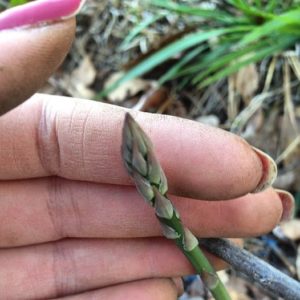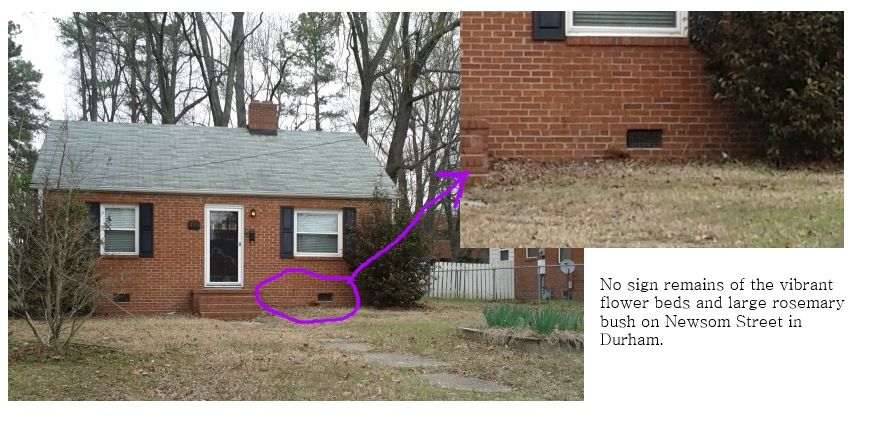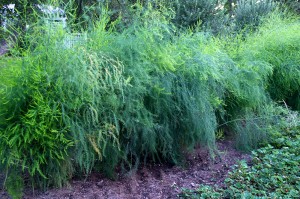by Joy Salyers

My friend (and amazing artist) Jessica Clark posted this pic on Facebook Tuesday. While she was rejoicing in it finally being the time of year when your nails are dirty for all the right reasons and things are sprouting, when I saw the beautiful asparagus spear, what I thought of was not shoots but roots.
Let me explain. Asparagus is a perennial, the fruit tree of vegetables. When you settle somewhere, put down roots, you think of making an asparagus bed like you’d think of starting an orchard.
Two elements make asparagus a long-term plant friend. First, whereas you can take short cuts with the prep work for a lot of plants, asparagus is one where careful advance soil and bed preparation really do seem to matter. (Here’s some advice from the NC Cooperative Extension on growing this wonderful treat.)
Second, there is no eating that asparagus the first year you plant it. While you can pick a spear or two the second or third year, you don’t really get a full harvest window (usually about 6-8 weeks long) until year four.
Well, I have lived in 18 different dwellings in my life, and I’m not quite 45. I think the longest I’ve ever lived consecutively in one house is three years. So despite the fact that I do love to garden – and I especially love perennials – you can see why asparagus plants have never made it onto on my shopping list. (Neither has foxglove, which I also love and which also takes at least two years to bloom.)
My time in North Carolina has been marked by a series of rental houses ranging from quaint to ramshackle. For a while, I embraced the maxim “Bloom where you’re planted.” At our tiny 1940s house in Durham (on a street of tiny brick houses built for workers of the Nello Teer family), I tore out the dying pine trees, planted a crepe myrtle, put in a raised bed in the front for vegetables, planted day lilies all along the side of the house, and most intensively, hand dug beautiful beds on either side of the front door. My friend Kirsten and I spent most of a day double-digging the bed on the right, where a rosemary plant grew up over the steps, making it easy to rub for good luck on your way in the house. I brought plants from my grandmother’s house as well – little things, like coral bells, lilies, and shamrocks – nothing fancy, but from family. When we moved away three years (of course) later, I dug up some of Grandma’s things as well as some bulbs and irises, but left a gracious plenty for the next tenant.

Now, the rosemary is gone, the front beds filled in. All that remains is the unkempt crepe myrtle, and the raised bed now filled with years of dead iris leaves.
At the next rental house, it was my mother-in-law who kindly pitched in to dig some beds.

The ground was incredibly hard – clearly nothing had ever been planted there – and the resulting beds were smaller. Knowing from my Newsom Street experience that my fantasy of paying it forward garden-wise was just as likely to result in a landlord sodding it over also discouraged me. With each passing house, fewer bulbs made it into the ground, and even fewer still got dug up again to move. By the last rental house (which definitely crossed the line to ramshackle), I didn’t plant anything at all.
But just about a year ago, I became a home-owner for the very first time. I’m still settling in and yet to get much past the phase of fantasizing about what my wooded yard will eventually look like, filled in with native plants and old family favorites. But the feeling of putting down roots is tangible, a kind of psychic exhale of a long-held breath. My children (who, bless their hearts, have already moved twice in their lives) asked me last week, “When are we going to move to another house?” My immediate response was, “Never!” When I saw Jessica’s photo this week, I suddenly realized, “Hey! I could plant asparagus!” And foxglove . . . and maybe even a fruit tree. Because goodness knows, I plan to be here a while.
If you have put down roots somewhere yourself for long enough to have a mature asparagus bed, here are a few tips:

The natural sugar in asparagus begins diminishing immediately after picking. So just as with corn, put the water on to boil before you head out to pick it! (And if you’re buying asparagus, get it the day it was picked if possible, and cook it asap.)
If freshly picked, thin spears aren’t any better than thick ones.
There’s certainly nothing wrong with munching on raw asparagus right from the garden, but it actually increases its nutritional content to cook it. Steam or simmer it for 3-5 minutes, or toss spears with olive oil and seasoning and roast them in the oven at 450 degrees for 15 minutes.
______________________________________________________
 Joy M. Salyers is Executive Director of the North Carolina Folklife Institute. She will work for food!
Joy M. Salyers is Executive Director of the North Carolina Folklife Institute. She will work for food!
Leave a Reply